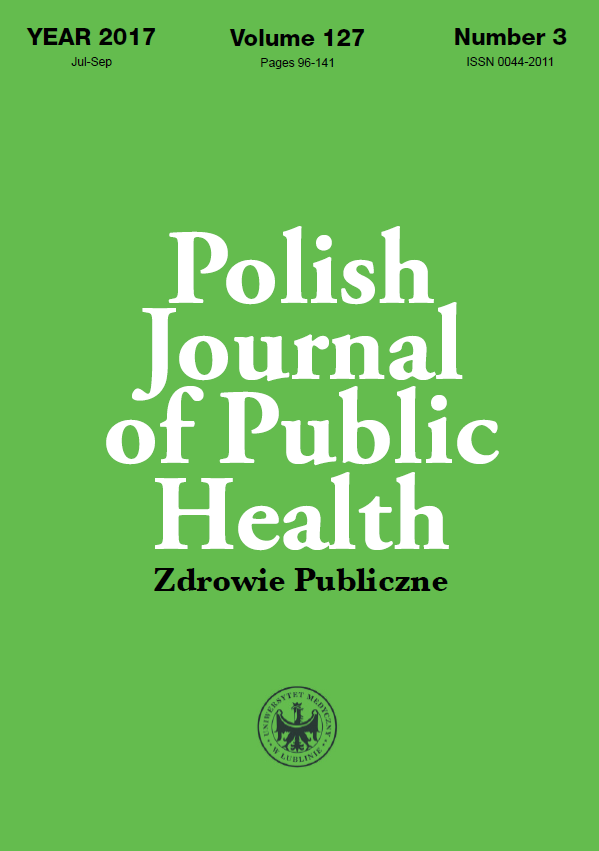Aggression of patients towards the employees of the National Emergency Medical System
DOI:
https://doi.org/10.1515/pjph-2017-0023Keywords:
aggression, verbal aggression, physical aggression, safety, medical rescueAbstract
Introduction. The organizational structure of the National Emergency Medical system ensures the health of citizens. Unfortunately, patients present dangerous behaviors, thereby damaging the safety of workers during medical emergencies. Aggression and violence, in spite of the widespread perception of it as a negative phenomenon undermining the individual’s health, is an indispensable part of everyday life and work environment.
Aim. The purpose of this study was to determine the incidence of acts of aggression that led to violence, and the types of occurrence of this phenomenon, which influenced the staff of the National Emergency Medical system.
Material and methods. The study was conducted in 2015/2016 among the employees of the National Emergency Medical system in Lublin, Puławy and Zamość; the research tool was a questionnaire survey.
Results. On the basis of the conducted research, it can be concluded that the employees of the National Emergency Medica system are, to a large extent, exposed to acts of aggression on the part of patients. Almost all the employees of the Accident & Emergency Units (98.2%) and almost all the employees of the Medical Rescue Teams (98.3%) encountered aggression from the patients.
Conclusion. There observed a phenomenon of aggression as well as verbal and physical violence on the part of patients towards health care workers. Alcohol and drugs increased both verbal and physical aggression among patients.
Employees of the National Emergency Medical system have indicated aggression as an intrinsic element in the work environment.
References
1. Karkowska D. Prawa pacjenta. Warszawa; 2009. p. 216-30.
2. Konstytucja Rzeczypospolitej Polskiej. Komentarz. T. I-V. L. Garlicki (ed). Warszawa; 1999, 2001, 2003, 2005, 2007.
3. Nogalski A, Mikuła-Mazurkiewicz A, Mojsym S. Aggression and violence at Emergency Department and Ambulance Service. In: E. Dybińska (ed). Lifestyle, education and wellness. Lublin: NeuroCentrum; 2012. p. 197-210.
4. Poździoch S. Komentarz: Ustawa o Państwowym Ratownictwie Medycznym. Warszawa: Wydawnictwo Wolters Kluwer S.A; 2013.
5. Rozporządzenia Ministra Zdrowia z dnia 6 czerwca 2013 r. w sprawie bezpieczeństwa i higieny; Dz. U. 2013 poz. 696.
6. Ustawa z dnia 6 czerwca 1997 r. Kodeks karny Dz. U. 2016 poz. 1137.
7. Projekt-ustawy-o-zmianie-ustawy-o-Panstwowym-Ratownictwie-Medycznym-oraz-niektor.html. [https://bip.kprm.gov.pl/kpr/form/r127427395].
8. Wolters Kluwer Polska. Agresja w ochronie zdrowia. [http://www.abc.com.pl/nowosci-branzowe/3374/7]. (18.02.2010)
9. Marek A. Kodeks karny. Komentarz. Lex a Wolters Kluwer business, cop. 2007. Warszawa; 2007.
10. Projekt z dnia 14.10.2016 [http://legislacja.rcl.gov.pl/docs//2/12290956/12384436/12384437/dokument249974.pdf] (15.07.2017)
11. Ustawa z dnia 5 grudnia 1996 r. o zawodach lekarza i lekarza dentysty. Dz. U. 2008 Nr 136 poz. 857.
12. Bryła R. Bezpieczeństwo i higiena pracy. Katowice: Wyd. ELAMED; 2011.
13. Karczewski JE, Karczewska KW. Zarządzanie bezpieczeństwem pracy. Gdańsk: Wydawnictwo Ośrodek Doradztwa i Doskonalenia Kadr Sp. z o.o.; 2012.
Downloads
Published
Issue
Section
License
Copyright (c) 2018 Polish Journal of Public Health

This work is licensed under a Creative Commons Attribution-NonCommercial-NoDerivatives 3.0 Unported License.


